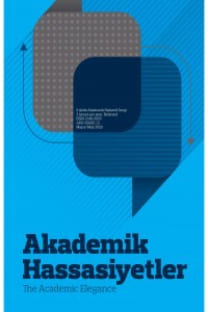MISIR’IN SOSYO-EKONOMİK YAPISI İÇERİSİNDE VERGİ SİSTEMİ’NİN GELİŞİMİ VE TÜRK VERGİ SİSTEMİ İLE KARŞILAŞTIRILMASI
Mısır Vergi Sistemi, Mısır Cumhuriyeti, Türk Vergi Sistemi, Mısır’da Vergi, Katma Değer Vergisi
COMPARISON OF EGYPTIAN TAX SYSTEM WITH TURKISH TAX SYSTEM
: Egyptian Tax System, Republic of Egypt, Turkish Tax System, Tax in Egypt, Value Added Tax,
___
- Abdulaziz, M. (2014). Plant Cotton. Arab Encyclopedia - Agriculture and Veterinery, 15, 470- 482. Erişim Tarihi: 30.11.2016, www.almasryalyoum.com/news/details/566822
- Abdulhamed, J. (2010). Financial Accounting and Tax. Erişim Tarihi: 29.07.2014, www. thanwya.com/vb/archive/index.php/t-261296.html
- Ao. Academy. (2012). Egyptian Tax Reform. Erişim Tarihi: 18.01.2014, www.ahewar.org/ debat/show.art.asp?aid=384568
- Banha University. (2009). Tax Accounting. Banha. Erişim Tarihi: 26.11.2013, http://bu.edu. eg/olc../images/8th-16%20(1).pdf
- Central Bank of Egypt. (2017). Annual Report.
- Dwaba, A. M. (2011). The Egyptian Ekonomik Reform After Rovolution of 25 January. Egypt: Dar El-Salam Publication.
- El-Abidin, S. Z. (2013). A Summary of a Study on Egyptian Cotton. Al Hiwar Al Mutamaden Journal (4259), 2-8. Erişim Tarihi: 12.01.2014, www.ahewar.org/debat/show.art. asp?aid=384568
- Hajazi, w. Y. (2008). Tax Accounting. Banha, Egypt: Banha University. Erişim Tarihi: 26.11.2017, www.olc.bu.edu.eg/olc/images/m7sbadrbia.pdf
- Khalil, H., & El-Bedewi, A. (2014). Status of Tax Regulations: Egypt and Tunisia. Beirut: Arab NGO Network For Develepment.
- Ministry of Finance. (2017). The Financial Monthly Bulletin. Aylık, Cairo. October 15, 2017 tarihinde alındı
- National Bank of Egypt. (2012-2016). Egyptian Economy in Figures - Annual Report. Öztürkler, H. (2012). Mısır Ekonomisinin Genel Özellikleri. Ortadoğu Analiz, 4(38), 51-57.
- SESRIC. (2016). Annual Economic Report On The OIC Countries. SESRIC. The Constitution of Egyp. (2014).
- The World Bank. (2016). Word Development Indicators.
- Türkiye Cumhuriyeti Ekonomi Bakanlığı. (2016). Mısır’ın Dış Ticareti. Erişim Tarihi:15.08.2016, www.ekonomi.gov.tr
- World Bank. (2016). Economic Indicators, Annual Report.
- 111 Sayılı Mısır Damga Vergisi Kanunu. (1980). Erişim Tarihi: 16.05.2018, www.incometax. gov.eg/pdf/damga.pdf
- 184 Sayılı Mısır Gümrük Vergisi Kanunu. (2013). Erişim Tarihi: 17.05.2018, www.egyptlayer.over-blog.com/2013/08/blog-post_7658.html
- 67 Sayılı Mısır Katma Değer Vergisi. (2016). Erişim Tarihi: 17.05.2018, www.mof.gov.eg/Arabic/_Layouts/MOF/ExternalPages/Laws/pdf/1808.pdf
- 91 Sayılı Mısır Gelir Vergisi Kanunu. (2005). Erişim Tarihi: 16.05.2018 www.slideshare.net/ mamdohosman/91-2005-17-2015
- ISSN: 2148-5933
- Yayın Aralığı: Yılda 3 Sayı
- Başlangıç: 2014
- Yayıncı: A Kitap
MODERN TOPLUMDA SERBEST ZAMANIN İŞLEVİ VE PLANLANMASI
KOSGEB GİRİŞİMCİLİK PROGRAMI: ELEŞTİREL BİR DEĞERLENDİRME
Mete Kaan NAMAL, Mustafa KOÇANCI, Beyhan AKSOY
HİZMETKAR LİDERLİK FİRMA PERFORMANSI İLİŞKİSİNDE ÖRGÜTSEL ÖZDEŞLEŞMENİN ARACI ETKİSİ
Elif BAYKAL, Cemal ZEHİR, Mahmut KÖLE
ESKİ SOVYET COĞRAFYASINDA YAŞAYAN ETNİK KORELİLER KORYO SARAM
ULUSLARARASI İNSAN HAKLARI HUKUKU VE DOĞRUDAN DEMOKRASİ ARASINDAKİ ÇATIŞMA: MİNARE YASAĞI
ULUSLARARASI İNSANCIL HUKUKTA İDARİ GÖZALTI VE DEVLET DIŞI SİLAHLI AKTÖRLER
Fatma TAŞDEMİR, Erdinç ÖZDEMİR
OKUL SOSYAL HİZMETİ BAĞLAMINDA İLKOKUL ORTAOKUL VE LİSE ÖĞRENCİLERİNİN DEVAMSIZLIK PROBLEMLERİ
ÇOCUK REFAHI ÇALIŞANLARININ TÜKENMİŞLİK VE MESLEKİ DOYUMLARI ÜZERİNE BİR İNCELEME
Rabia ÇOBAN KAYNAK, Rıza GÖKLER
TÜRK PARTİ SİSTEMİNDE PARÇALANMIŞLIK VE SEÇİMSEL DALGALANMALAR
